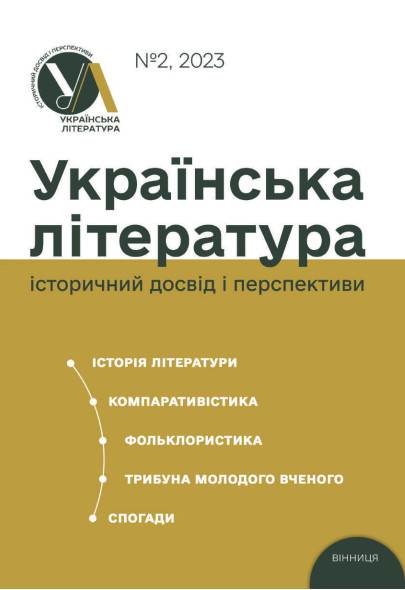Parables in the poetry of dissenters and hermetists (using the lyrics of Taras Melnychuk and Vasyl Herasymiuk)
https://doi.org/10.31652/3041-1084-2023-2-39-48Published 2023-11-15
Keywords
- lyrics, dissidents, hermetic poetry, symbol, metaphor, parable, fairy tale
Copyright (c) 2024 Ірина Зелененька

This work is licensed under a Creative Commons Attribution 4.0 International License.
How to Cite
Abstract
In modern Ukrainian literary studies, the problems of generational dialogues and conflicts, the heredity and discontinuity of the literary process in Soviet and independent Ukraine, as well as the restoration of the authenticity and originality of lyrical writing, the peculiarities of generational experiences, are actualized. Scientists are interested in designing the encoding of images and symbols in the lyrics of resistance members, in particular, dissidents and hermeticists, representatives of two forms of dissent — open and hidden. The modelling of history and reality in the work of Taras Melnychuk and Vasyl Herasymiuk, two poets from the Hutsul Region, still seems exotic, as it does not declare any phenomenon, but retells it as a strange phenomenon, as a fate, as a molfarism, as hereditary, as exceptional and usual at the same time. The core of the resistance literature was the imagery of the poetry of several generations, in particular dissidents and hermetists, which stood out from the mass of poetry of the second half of the 20th century with its fairy-tale and parable imagery. This literature of the resistance movement is well characterized, but not qualified by modern sources. Very interesting in this sense is the design of symbols and codes based on the metaphorical processing of ethnicity (partially relict). The lyrics of dissidents and hermeticists are, in fact, a demonstration of open (extroverted) and hidden (introverted) forms of resistance to the regime — through a parable, a fairy tale, a myth. The national culture revealed by the two poets in the poems is a contemplative part of their Europeanness, and therefore embodied both in dominant images and in explanations somewhat similar to exegesis, creating a completely underground allegory. Taras Melnychuk and Vasyl Herasymiuk are two Hutsul poets who not only offered readers to model reality based on its exoticization, but also to implement ethnocodes, oddities and molfarism as a tool to fight against totalitarianism. This is a manifestation of the form of the authors’ stoic positions, and is not only perceived as an expression of the beauty of the Carpathians and the Hutsul region.
Downloads
References
- Герасим’юк В. Діти трепети. Київ : Молодь, 1991. 126 с.
- Герасим’юк В. Космацький узір. Київ : Рад. письменник, 1989. 135 с.
- Герасим’юк В. Поет у повітрі. Вірші і поеми. Львів : Кальварія, 2002. 144 с.
- Герасим’юк В. Потоки. Київ : Молодь, 1986. 119 с.
- Герасим’юк В. Смереки. Київ : Молодь, 1982. 87 с.
- Дзюба І. ... І є такий поет : передмова. Герасим’юк В. Була така земля : Вибране. Дзюба І. Київ : Факт, 2003. С. 7–20.
- Зелененька І. Рецепція «Тіней забутих предків» Михайла Коцюбинського в ліриці Тараса Мельничука й Василя Герасим’юка. Літературознавчі студії: Збірник наукових праць. Випуск 17. Вінниця : «ТВОРИ», 2023. С. 38–49.
- Зелененька І., Ткаченко В. Сюжетні особливості поезії руху опору другої половини ХХ століття в Україні (на прикладі лірики дисидента Тараса Мельничука). Актуальні проблеми філології та перекладознавства. Хмельницький, 2023. № 27. С. 52–55. https://doi.org/10.31891/2415-7929-2023-27-26 DOI: https://doi.org/10.31891/2415-7929-2023-27-26
- Зелененька І. «Чиї це ілюзії стенають плечима, якого народу…» : Тарас Мельничук і літературний процес 60-90-х років в Україні.
- Вінниця : «Едельвейс і К», 2008. 152 с. DOI: https://doi.org/10.1158/AACR.EDB-08-894
- Зелененька І., Ткаченко В. Етнокультурні коди в українській поезії доби реакції: від дисидентів до герметистів, від Тараса Мельничука до Василя Герасим’юка. Філологічна освіта і наука: трансформація та сучасні вектори розвитку: наукова монографія. Рига, Латвія : «Baltija Publisching», 2023. С. 179–193. https://doi.org/10.30525/978-9934-26-283-8-7 DOI: https://doi.org/10.30525/978-9934-26-283-8-7
- Ковалів Ю. З одного джерела. Діалектика художнього пошуку. Літературний процес 60–80-х рр. / авт. кол. Агеєва В., Бойко Л., Вакуленко Д., Дончик В. та ін. Київ : Наукова думка, 1989. С. 81–107.
- Кут С. Поетична воля, або Апперцепція підрубаної вишні (До питання про світогляд Т. Мельничука). Прообраз : Літературно-мистецький альманах. Івано-Франківськ : Плай. 1998. Вип. І. С. 107–111.
- Мельничук Т. Із-за ґрат : Поезії. Передм. О. Зінкевича. Балтимор : Торонто : Смолоскип. Імені В. Симоненка. 1982. 130 с.
- Мельничук Т. Князь роси : Поезії. М. Жулинський. Князь роси : передмова. Київ : Молодь, 1990. 152 с.
- Мельничук Т. Моє ліплення оленя: поезія. Передм. В. Карпюка, М. Лаюка. Брустурів : Дискурсус, 2018. 128 с.
- Мельничук Т. Чага : Поезії. Передм. Я. Дорошенка. Коломия : Вік, 1994. 176 с.
- Моклиця М. Український модернізм у європейському вимірі. Волинь філологічна : текст і контекст. Луцьк : Вежа, 2008. Вип. 6. Ч. 1. С. 93–102.
- Моренець В. Прощання з ідеологічною вічністю: поезія 80–90-х р. Березіль. 1997. № 1–2. С. 166–172.
- Пушик С. Доля поета : Маловідоме з життєпису Т. Мельничука. Листи Тараса Мельничука до С. Пушика, П. Добрянського, ненадруковані вірші Тараса Мельничука. Березіль. 2003. № 1–2. С. 66–71.
- Рубчак Б. Бо в нас немає часу. Сучасність. 1990. № 11. С. 40.
- Салига Т. Між традицією і модерном (Штрихи до портрета Василя Герасим’юка). Дзвін. 1996. № 9. С. 123–130.
- Тарнашинська Л. Василь Герасим’юк: «Найдовша дорога…», або Хоча все мало би бути навпаки. Закон піраміди : Діалоги про літературу. Київ : Унів. вид.-во «Пульсари», 2001. С. 107–113.





